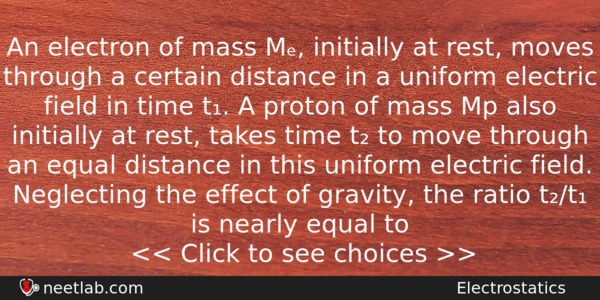| ⇦ | 
| ⇨ |
An electron of mass Mₑ, initially at rest, moves through a certain distance in a uniform electric field in time t₁. A proton of mass Mp also initially at rest, takes time t₂ to move through an equal distance in this uniform electric field. Neglecting the effect of gravity, the ratio t₂/t₁ is nearly equal to
Options
(a) 1
(b) √(Mp/Mₑ
(c) √(Mₑ/Mp
(d) Mₑ/Mp
Correct Answer:
√(Mp/Mₑ
Explanation:
No explanation available. Be the first to write the explanation for this question by commenting below.
Related Questions: - Eddy currents are used in
- The drift velocity of the electrons in a copper wire of length 2 m under
- A particle is dropped vertically from rest, from a height.The time taken by it to fall
- A body of mass 2 kg is moved by a force F=3x where x is the distance covered.
- In a compound microscope, the focal length of the objective is 2.5 cm and of eye lens
Topics: Electrostatics
(146)
Subject: Physics
(2479)
Important MCQs Based on Medical Entrance Examinations To Improve Your NEET Score
- Eddy currents are used in
- The drift velocity of the electrons in a copper wire of length 2 m under
- A particle is dropped vertically from rest, from a height.The time taken by it to fall
- A body of mass 2 kg is moved by a force F=3x where x is the distance covered.
- In a compound microscope, the focal length of the objective is 2.5 cm and of eye lens
Topics: Electrostatics (146)
Subject: Physics (2479)
Important MCQs Based on Medical Entrance Examinations To Improve Your NEET Score
18000+ students are using NEETLab to improve their score. What about you?
Solve Previous Year MCQs, Mock Tests, Topicwise Practice Tests, Identify Weak Topics, Formula Flash cards and much more is available in NEETLab Android App to improve your NEET score.
Share this page with your friends

Explanation